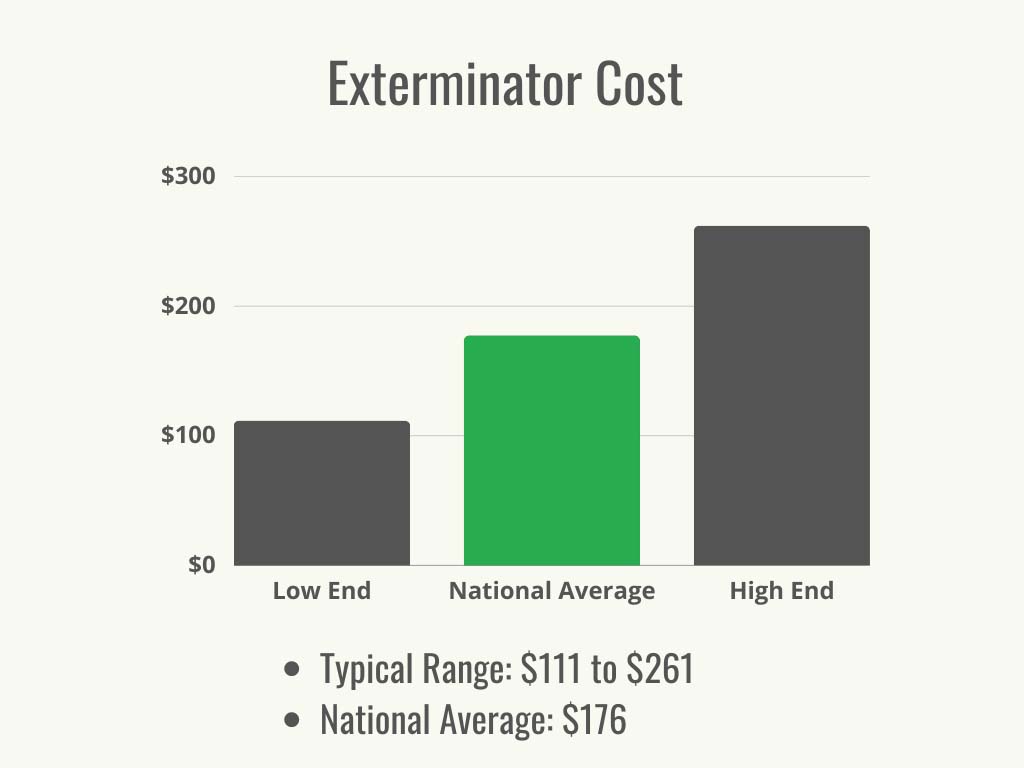

We may earn revenue from the products available on this page and participate in affiliate programs. Learn More ›
Highlights
- The typical range for exterminator costs is from $111 to $261, with a national average of $176.
- The main cost factors for hiring an exterminator are infestation type and size, location and accessibility, treatment type and frequency, property size, pest inspection, exterminator company, and cost difference between pest control versus wildlife control.
- Hiring an exterminator has major benefits, including cost efficiency, safety, thoroughness, and eradication of the root of the pest problem.
- While homeowners and renters may be able to take care of a minor pest issue themselves, infestations that are severe or overwhelming are best taken care of by a professional exterminator for the safety of the home’s residents.
A sudden bloom of spiders in the springtime, a trail of tiny ants, or the occasional group of fleas can be dismissed as seasonal nuisances. But a cockroach scuttling out of sight in the corner, mouse or rat droppings in the pantry cabinet, wood dust suggesting termites, or a string of bed bug bites is another issue entirely and can quickly become a matter of health and safety. For small infestations, residents may be able to handle extermination themselves, but larger infestations or pests can cause structural damage or serious health concerns that warrant professional treatment. So how much does an exterminator cost? According to HomeAdvisor, customers can expect to pay between $111 and $261, or a national average cost of $176. Before residents call in assistance, there are several factors to consider and questions to ask when assessing how much to budget.
Factors in Calculating Exterminator Cost
While the typical range for exterminator cost nationally is from $111 to $261, there are several factors that can push the total considerably higher and others that can make the experience less expensive. According to Zach Smith, owner of The Pest Dude, labor accounts for a large portion of these costs. “Pest control companies are typically charging upwards of $150 per man hour, and that often includes charging for one-way travel. The homeowner is incurring quite a bit of cost for the convenience of having somebody else handle it,” he explains. Labor costs can be further broken down based on the size of the infestation and ease of accessibility for the technician. Another important consideration for residents is whether they can handle the emotional impact of finding pests in the home and whether managing the situation is something they can tolerate on their own. Pest infestations cause panic in many people, even when it’s not necessarily logical, which is why so many memes and social media posts encourage those who have discovered giant spiders or rodents homes just to burn the whole thing down. Since that’s not a good option, knowing the components that build a pricing structure for professional exterminators will help unnerved customers feel like they have a better grip on the situation.
Infestation Type and Size
Pest control costs are not one-size-fits-all. It costs more to hire an exterminator to deal with a severe termite problem than it does to hire an ant exterminator. This is because of the damage that termites can do and the number of repeat visits that may be necessary to squash the infestation. An ant exterminator costs about $60 to $215, whereas termite extermination costs up to $3,000—or potentially more for severe infestations. Wildlife control is often a onetime visit that costs $400 to $600. Mice exterminators cost $150 to $200, but repeat visits may be necessary. Hiring a bed bug exterminator costs $145 to $500. The severity of the rodent or pest infestation can account for these wide cost ranges. The longer an infestation has had a chance to spread, the more visits the pest control company will need to make, and the more product they may have to apply. It’s a good idea for residents to call an exterminator at the first sign of a problem to keep costs to a minimum.
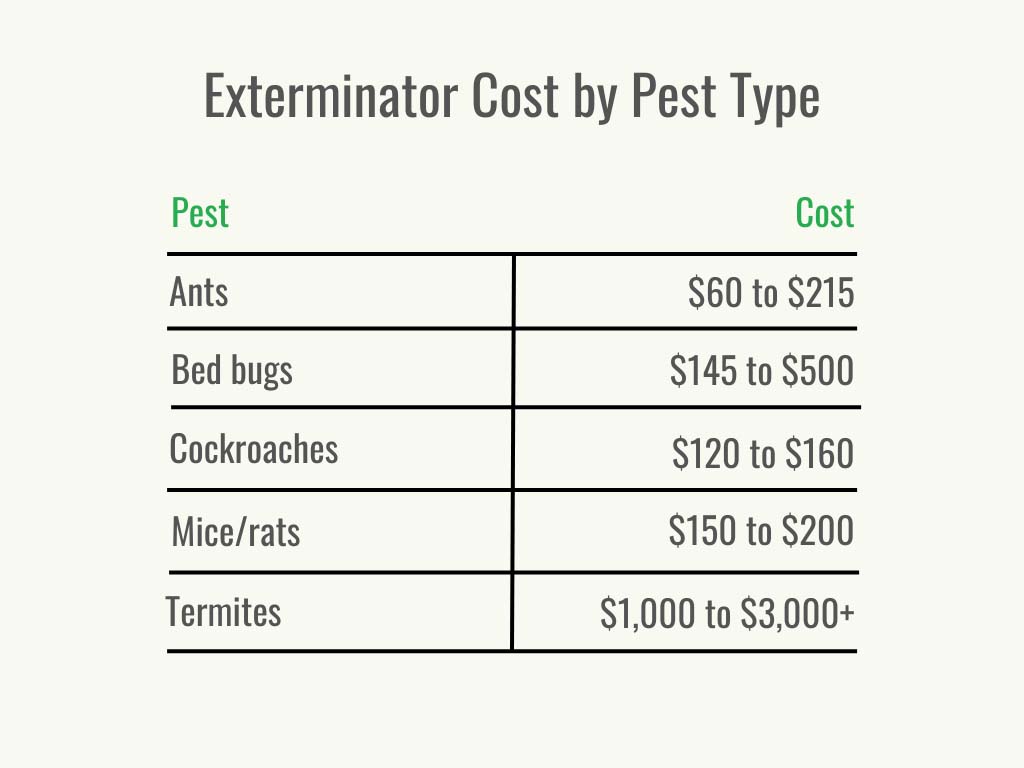
Infestation Location and Accessibility
Surface infestations are relatively easy to treat with traps or chemicals. If the infestation is inside the walls or structural wood, the solution will be more expensive, especially if it requires total fumigation to treat unreachable areas. If the technician charges an hourly rate, more time spent trying to access the infestation will result in a higher bill. Inaccessible infestations can also result in the need to open walls and repair them after the treatment is complete, adding to total costs.
Treatment Type
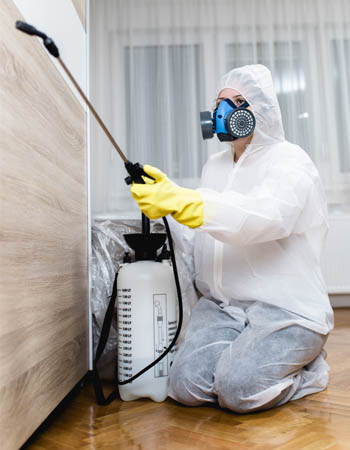
The cost of the treatment itself will vary based on several different factors. What kind of treatment is necessary? Is it a onetime treatment, or will there be recurring visits? Will the treatment be simple chemical applications or physical traps, or will the home need to be fumigated? Some treatment is basically free: Removing the attraction that convinced the pests that the home was an ideal spot is the first step. But some pests, like bed bugs and wood-boring insects, will drive up costs—in fact, termites are some of the most expensive pests to treat.
Basic physical pest control will be the first step in most cases, including nest removal, traps, and bait and trap stations. These will cost in the range of $300 to $700, depending on the type and size of the infestation and the number of visits that are necessary. Chemical sprays can range from $200 to $1,000 per room, while heat treatment and full fumigation for a 2,000-square-foot home can cost anywhere from $2,000 to $8,000.
Treatment Frequency
Some extermination needs are simple enough to be completed in a single visit, while other infestations require a longer plan of treatment to remove the pests altogether and prevent a recurrence. For example, flea exterminator costs are higher because fleas’ tiny size makes it difficult to tell when all bugs and eggs have been removed. So how much do exterminators cost for repeat visits? This can depend on the length of the contract, but often monthly costs come to $40 to $70 per visit. The costs do not necessarily correlate with the length of treatment, however. The best pest control companies, such as Orkin or Terminix, can provide customers with more precise pricing information.
| Treatment Frequency | Cost per Visit |
| Onetime | $100 to $350 |
| Initial | $85 to $190 |
| Monthly | $40 to $70 |
| Quarterly | $110 to $250 |
| Annual | $250 to $475 |
- Onetime visit: While the cost of the actual treatment portion of a single-visit extermination may be lower than the cost of a longer-term contract, the total cost may be a bit more than average. That’s because a onetime visit includes assessing the problem, tracking down the nests and access points, applying the treatment, and identifying steps that must be taken to prevent reinfestation. These single visits range from $100 to $350. If the single visit removes a single pest, such as a snake that made its way in from the garden, the cost may be a bit less.
- Initial visit: For problems that can’t be treated in a single visit, the initial visit will encompass performing an inspection to assess the problem, finding the entry points and nests, and designing a treatment plan, along with applying the initial treatment itself; the cost will be between $85 and $190.
- Monthly visit: Someone who has had a large infestation removed previously or lives in a multifamily home or apartment with a persistent problem may need to contract for monthly treatments to keep the space free of pests. These visits average between $40 and $70 per month or $600 to $1,300 per year.
- Quarterly visit: For treatment of seasonal infestations or as a preventive measure against reinfestation if a home is particularly susceptible to pest infiltration, it might be wise to opt for quarterly treatments. These average between $110 and $250 per visit.
- Annual visit: For those who don’t have recurring or significant pest problems, an annual treatment to prevent seasonal invasions of ants or mosquitoes can serve two purposes: The treatment will prevent even mild infestations of seasonal pests and provide an opportunity for a regular inspection for more insidious pests such as termites or rodents. These visits run between $250 and $475 each, depending on the region and the type of inspection.
Property Size
Pests do not helpfully stay in the first location they find to nest—they will perpetually hunt for a spot with better access to food and water sources. Therefore, the larger the home and yard, the more expensive extermination will be. There’s more space to inspect and more locations in which treatment will be necessary to avoid simply driving the pests from one location to another. For spaces over 1,500 square feet, some exterminators will charge an extra $25 per 1,000 square feet.
Pest Inspection
Most pest control professionals will do an inspection or initial visit to assess the scope of the problem and the type. During this visit, the exterminator will look for evidence of an infestation, locate the nest or entry points, and create a treatment plan. Often, upon homeowner’s approval of the plan, the exterminator will then apply the initial treatment and set mitigation strategies in place; in some cases, this may be the only necessary visit. A consultation visit will usually cost between $75 and $125, and this cost may be waived if a customer chooses to follow the suggested treatment plan. Sometimes a technician will set baited traps and check them later for signs of pest activity. This can cost $50 to $150. If the exterminator expects the problem is severe, they may also bring dogs to the home to sniff out nests. This costs $200 to $500.
Exterminator Company
Often the answer to “How much does an exterminator cost?” will depend on the pest control company. While it may be tempting for a customer to hire the company with the lowest prices, it’s a good idea to evaluate the best fit based on customer reviews, the services offered, and the length of time the company has been in business, in addition to affordability. Below are some of the most popular extermination services in the U.S. Customers will want to keep in mind that while some companies operate nationally, others have locations only in select regions. Customers can do an online search for “exterminator near me” to find local options, but the average costs for some of the best-known companies are listed in the table below.
| Exterminator Company | Cost |
| Abell | $95 to $400 |
| Aptive | $560 to $620 |
| Arrow Exterminators | $130 to $600 |
| Bulwark Exterminating | $75 to $455 |
| Dewey | $100 to $400 |
| Ehrlich | $125 to $550 |
| Orkin | $170 to $500 |
| Terminix | $175 to $450 |
| Truly Nolen | $175 to $500 |
| Viking Pest Control | $75 to $350 |
| Western Exterminator | $125 to $400 |
Pests vs. Wildlife
Exterminators perform many different tasks, so it’s important for customers to distinguish between pest removal and wildlife removal in terms of costs. Pest removal entails the removal of insects or rodents that have moved into a home and set up camp—they’re co-residents who plan to stay and require removal with multiple strategies. If a raccoon or family of bats has gotten into the attic, the same exterminator might come out to help physically remove them (usually for between $400 and $600) and make recommendations as to how to close off their access point, but it will probably not be a recurring problem once that access point is closed. The greater cost for wildlife removal will most likely be damage repair and access point remediation.
Indoor vs. Outdoor
Indoor pest control is what most people think of when they consider calling an exterminator. Still, outdoor pests, such as skunks, groundhogs, moles, and even coyotes and foxes, can make outdoor living spaces undesirable or unsafe. Exterminators can work on live trapping and relocation of those outdoor pests. Outdoor services may be limited by local ordinances guiding relocation or trapping policies for different species of wild animals.
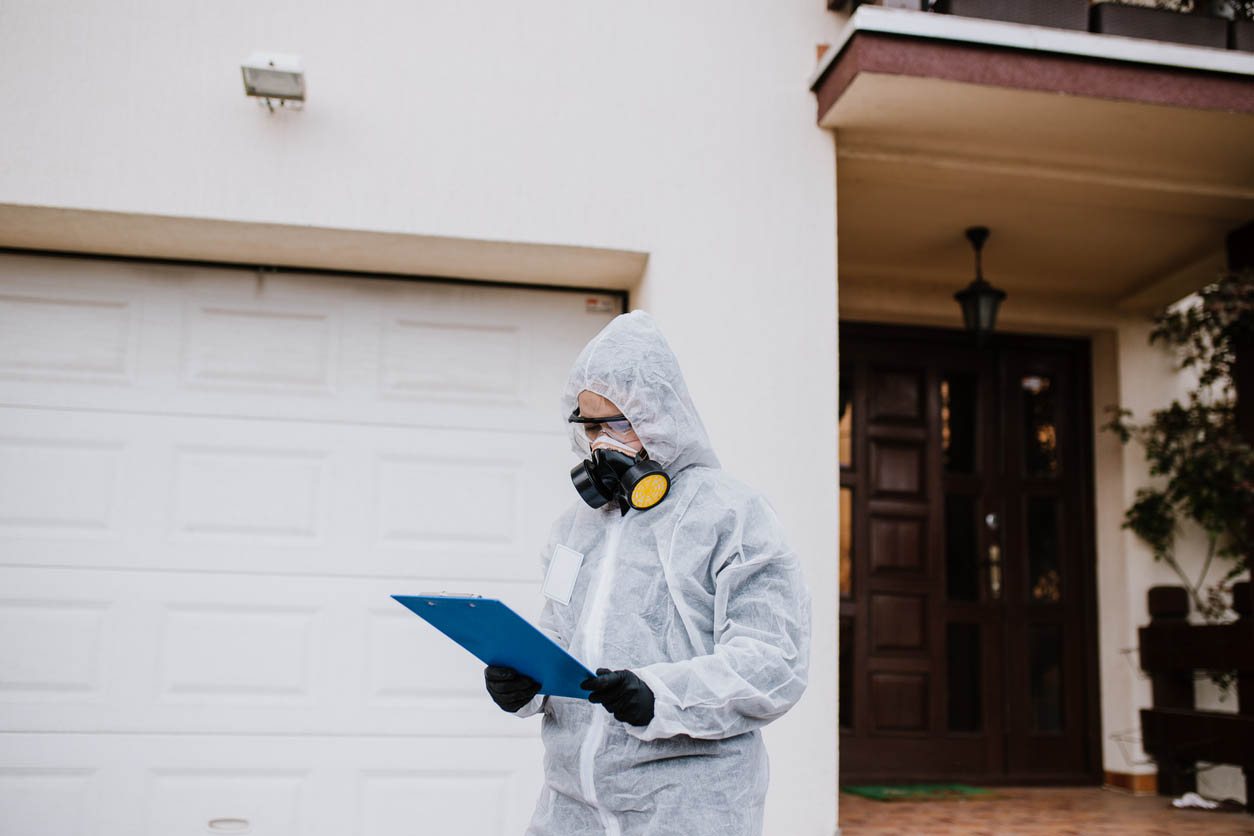
Additional Costs and Considerations
Once the customer has determined the type of treatment they need, there are a few other elements of pest control for them to consider in the overall cost. The most significant of these is the number of exterminator visits needed to fully eradicate the infestation, but other expenses might be surprising to a customer. Cleaning, necessary repairs, and prevention may seem like extra costs, but these are essential to reduce the likelihood that treatment for reinfestation will be necessary.
Cleaning
For many homeowners and renters, discovering any kind of pest triggers an instantaneous desire to scrub down all surfaces. This isn’t a bad idea, as it will also probably remove attractions for the pests. But the time for serious cleaning is after the treatment has occurred, especially if chemicals were used to remove residue, pest droppings, and any other potential problems. The cost for this process will depend on whether a resident will be purchasing supplies and protective gear such as masks, gloves, and HEPA vacuum filters to do the job themselves or hiring a full house cleaning service, which will cost between $120 to $240, or $200 to $400 for a deep clean. This may seem like an extraneous cost, but the chemical residue and droppings can be health hazards, and knowing that a home is truly and completely clean will provide peace of mind. It’s also worth considering weekly cleaning for $75 to $250 as it could reduce the likelihood of reinfestation.
| Cleaning Service | Cost |
| Routine | $120 to $240 |
| Deep | $200 to $400 |
| Weekly | $75 to $250 |
Home Repairs
Depending on the type of pest that is present in the home, repairs can be as minor as sealing cracks in the foundation or as significant as replacing wiring and plumbing or structural wood. Some insects like to burrow underneath carpeting, chewing on the fibers and adhesive, so carpet replacement may be necessary. If the exterminator needs to open walls to access nests, those walls will need to be patched and painted for $300 to $880. Termites and carpenter ants can damage walls, studs, roofs, and floors, requiring major repairs. Mice and squirrels are attracted to the insulation of older wiring and may chew through enough to require a major overhaul. Electrical rewiring can cost as much as $2,300. These repairs are difficult to estimate ahead of time, as it’ll only be clear that they’re necessary after the inspection and treatment are complete. However, they are an excellent motivator for a homeowner or renter to seek professional help as soon as it seems like there may be a pest problem rather than putting off treatment while the situation gets worse and more expensive to repair. The following are some common repairs and their average costs.
| Repair Type | Cost |
| Carpet installation | $790 to $2,800 |
| Drywall repair | $300 to $880 |
| Electrical rewiring | $560 to $2,300 |
| Flooring repair | $200 to $570 |
| Insulation replacement | $2 to $7 per square foot |
| Plumbing repair | $150 to $350 |
| Water damage cleanup | $1,240 to $5,260 |
Preventive Measures
After the treatment is complete (or even before, if the home is vulnerable to pests), taking some preventive steps can help residents reduce the likelihood of an infestation or its seriousness. The exterminator will usually have some recommendations that may include regular treatment visits. Still, additional steps a resident can take on their own may cost less than repeat visits. Insect prevention can cost anywhere from $600 to $10,000. If termites have been removed in the past, prevention of reinfestation is critical, as the evidence of a recurrence may not show itself until the walls start crumbling; applying one of the best termite treatments in powder or liquid form can help at a fraction of the cost of professional treatments. Spiders and other small insects can be repelled with one of the best spider killers, which will help drive them away. Rodent prevention is somewhat less costly at $25 to $1,100. For DIY options, residents can take steps to seal cracks in the exterior of the home, keep the lawn and gardens neatly pruned and trimmed, and have the gutters cleaned regularly. The best way to keep out wildlife nuisances is to install fencing, which costs $3,500 to $6,500. If these measures don’t work, then professional prevention assessment may be necessary at an additional cost.
Exterminator Cost by Type of Treatment
Along with the type and size of the infestation, the removal method will have a significant effect on the total cost of the project. These methods are not interchangeable, so there’s not a lot of negotiation to be done. An exterminator will know the most effective remedy for each type of pest, and while it’s a good idea for a customer to seek out more than one estimate and plan for treatment, after choosing an expert it’s vital to trust their treatment recommendation. Under-treating can lead to potential reinfestation and additional cost.
| Treatment Type | Cost |
| Chemical | $100 to $500 |
| Fumigation | $2,000 to $6,000 |
| Heat | $2,000 to $6,000 |
| Insect traps | $100 to $400 |
| Physical removal and relocation | $150 to $700 |
Chemical
Chemical treatment is the most common form of pest control treatment. Delivered in powder, spray, or bait form, chemical pest control is designed to exterminate the pests where they are. Many companies offer organic forms of chemical treatment that are designed to be less harmful to humans and pets, but it may be necessary for residents to leave home for a few days while treatment is in progress. If this is the best option, it’s a good idea for customers to ask many questions about the type and application methods of the chemicals and make sure the exterminator knows about anyone in the home with sensitivities to chemicals. It is, generally, quite effective. Chemical application to kill an infestation costs between $100 and $500.
Fumigation
Fumigation is typically a last-resort extermination method, reserved for severe infestation or after all other methods have failed. It’s often used in multi-unit structures where insects can pass between units through the walls. The home or building is sealed, and a chemical mist is deployed in the closed space and left to sit for some time. The house then needs to sit for another period of time to air out before residents can return. Fumigation is both expensive ($2,000 to as much as $6,000, depending on the structure and infestation) and inconvenient for residents, but there’s no arguing that it’s effective—especially in cases where insects have bored into structural wood or the problem is so widespread that it can’t be contained.
Heat
Heat treatment can be a great (if expensive) option for those who prefer to avoid chemicals but have significant infestations, especially bed bugs or other tough-to-kill insects. Costing between $2,000 and $6,000, heat treatment requires that the home be sealed and pumped full of superheated air. Exposure to heat kills the insects along with their larvae and eggs. It’s pretty effective, and because no chemicals are used, there’s no waiting period after the treatment: Residents can re-enter the house immediately after the treatment is complete.
Insect Traps
Traps are often a simple and affordable solution to insect problems that are not severe. The best cockroach exterminators often utilize baited traps. Cockroach exterminator costs range from $120 to $160 on average. Other bugs can be lured with sticky tape that is treated with pheromones. Insect trapping with either of these methods can cost anywhere from $100 to $400 for most homes.
Physical Removal and Relocation
Physical removal and relocation is the preferred treatment for larger pests and wildlife, along with beehives or wasp nests. Physical treatment is the careful physical removal of the nest or the trapping and relocation of an animal. This requires the exterminator to be up close to the pests at some personal risk and therefore requires more protective apparel, which comes at a slightly higher cost. In addition, if a family of animals has invaded, the exterminator might need to return over several visits to make sure all the animals have been removed. Whether hiring one of the best mouse exterminators or a wildlife control service, customers can expect to pay $150 to $700 for physical removal.
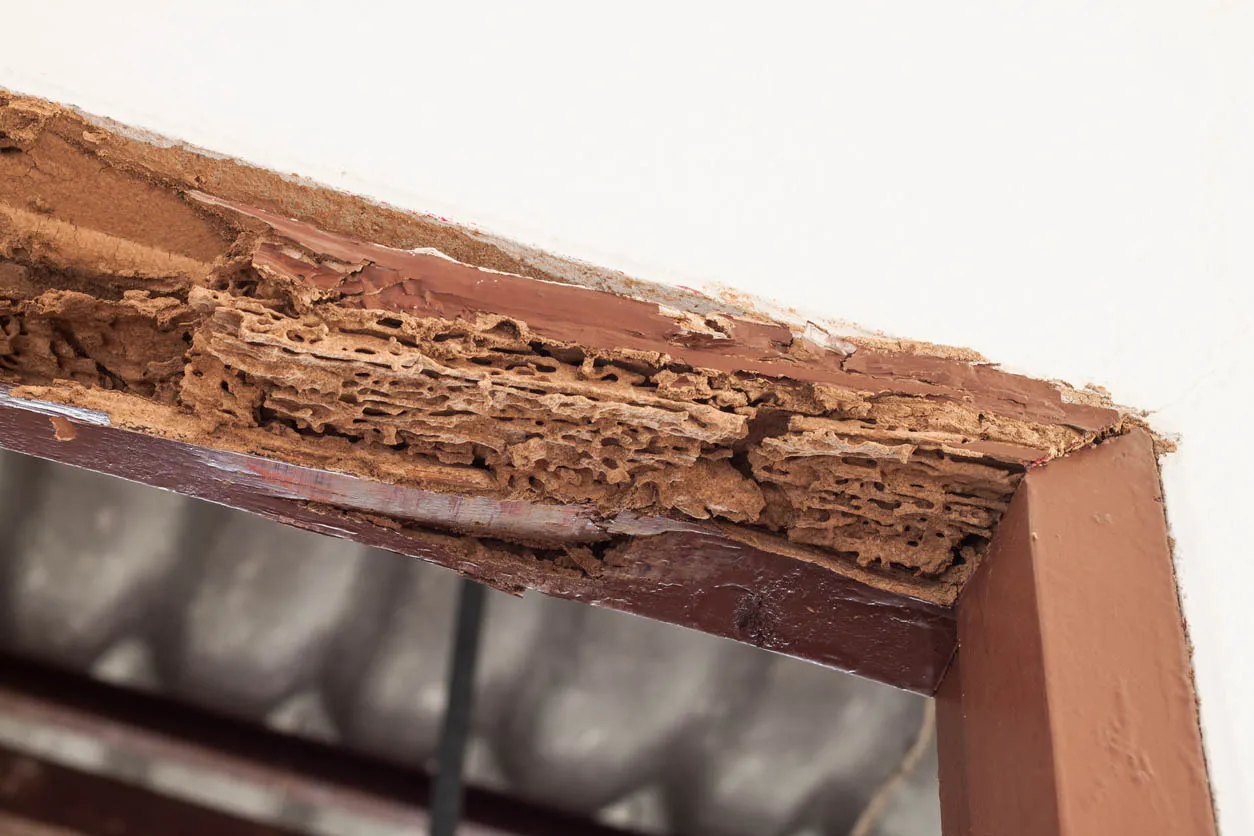
Do I Need an Exterminator?
When is it time to call an exterminator? There are several warning signs that homeowners and renters will want to watch out for that suggest a pest problem has gotten out of hand and needs professional attention.
Signs of Pests
With pests, what is visible is usually the tip of the iceberg. If they’re confident enough to be out of hiding, they must have plenty of backup in the nest. The following signs of pests probably mean that the problem is beyond the scope of what can be done without professional help.
- Strange sounds like squeaking, scratching, or flapping emerging from behind walls can often indicate rodent, wildlife, or even termite problems.
- Unpleasant odors that don’t have an obvious source are another sign of pests. For example, dead mice in the walls have a distinctive smell, and bed bug infestations carry a musty scent.
- Droppings can provide valuable clues to what pest is in the home. For example, dark droppings the size of a grain of rice in pantries and cabinets are likely from mice.
- Damaged furniture and upholstery can mean that these items have become a snack for whatever pest is plaguing a home. Small red or dark brown stains usually indicate it’s time for the resident to call one of the best bed bug exterminators for help.
- Sightings are as much proof as can be hoped for that pests are present—this means it’s time for a resident to call a pro.
- Footprints on countertops, crumbs in the pantry, or small gnaw marks on food packaging typically mean that rodents are making themselves comfortable. Their dirty feet or fur leave tracks on light-colored surfaces, and they can leave crumbs after raiding the pantry.
- Nests are another telltale sign that pests have set up shop in a home permanently. It also means they are probably breeding. An exterminator will need to remove the nests and take further action to get rid of them for good.
Homeowner or Renter Uncertainty
For homeowners and renters who like to manage their own home problems, the first sign of a pest problem will send them to the pest control aisle of the nearest home improvement store. But if they’re not precisely sure what kind of pest they’re dealing with, the time and money spent trying to eradicate the pests can be wasted when the method doesn’t work. Maybe the very presence of the pests is too much to handle. Maybe there are too many of them, and it isn’t clear what to do or where to begin. A consultation with a good exterminator will make it easier to assess the problem and could save money in the long run whether through a contract or for a onetime visit.
Children or Pets
Many times, household pets already know about the pests in a home long before their owners do, and the superior sense of smell that tells them that there are other animals present also makes them very vulnerable to DIY chemical methods. Young children may also be adversely affected by sprays and poisons and are at greater risk from bites or stings. If it seems like there are pests and there are also children or pets in the home, it’s best to call an exterminator, who can use child- and pet-safe removal methods.
Failed DIY Methods
If DIY pest control hasn’t worked, it’s time for the resident to call in some backup. Often, it makes sense for residents to try basic remedies first, but if these are unsuccessful, a professional will need to resolve the problem before it gets bigger.
Recurring Infestations
Recurring infestations aren’t usually recurring. If it seems like a home is finally pest free, and then a week later the residents find more, this is not a reinfestation. It’s more likely that the job was not completed the first time, and the stragglers have now multiplied. Hiring the right pro from the beginning can help prevent this issue.
Pest Extermination: DIY vs. Hiring a Professional
A few moths, a handful of stink bugs, or one or two mice in the basement are probably pest problems that most homeowners or renters can approach themselves using hygienic, chemical, or physical treatments from a home improvement store. If these basic remedies don’t solve the problem or even that is too much to contemplate, hiring a professional is often a good decision. Smith offers the following situations as signs that it is time to call a professional exterminator: “You know it’s time to hire a professional when: 1. After reading the instructions on how to take care of it yourself, you still feel unsure. 2. You have any concern about handling pesticide or other pest control materials yourself. 3. If you just don’t have time for the initial or the many follow-up treatments. 4. Emotionally you just feel overwhelmed by the presence of the pest.” In some cases, such as a bed bug infestation, lots of rodents, or large quantities of ants, roaches, and termites, it will be vital for a homeowner or renter to call in a professional as soon as possible to prevent damage to the home and its residents’ health. While the cost of extermination can feel like an insult to customers because there’s no way to plan or budget ahead for it, there are plenty of solid reasons to outsource this task to one of the best pest control companies.
Cost Efficiency and Warranties
The costs of buying bait, sprays, poisons, gap seals, caulk, and traps can mount up quickly—so quickly that many homeowners or renters spend more buying their DIY supplies than they would have spent on an exterminator who could have done the job more efficiently and quickly. “[While] there’s a lot of available information on the internet, and the professional-grade products can be purchased online, sometimes the quantities of these materials make it cost-prohibitive,” says Smith. “Nobody needs to buy a $300 bottle of insecticide for a small project at home. It’s cheaper in those times to go with a pro.” Also, many extermination companies warranty their work with promises of free treatments if reinfestation occurs during a specific period. A homeowner or renter may spend the same amount or slightly more on a professional application than they would doing it themselves. Still, follow-up treatment and the overall reduction in their own effort make the professional a more efficient option.
Safety
Rodents can spread disease, and bites from all pests can cause reactions or become infected. Trapping and relocating animals without having the proper skills can result in panicked animals that act aggressively. In addition, the powerful chemical sprays, baits, and powders can be dangerous if misapplied. A professional exterminator can get into the house, gauge the proper treatment, and apply it while providing customers with guidance about safety considerations and removing the pest problem faster.
Thoroughness
Most homeowners or renters won’t eliminate all the pests with DIY methods and won’t know how to check. Pests like termites and bed bugs are insidious and excellent at hiding. Exterminators know how and where to look and follow up to snuff out any lingering pests before a full reinfestation can occur.
Eradication of Root Problem
Most residents can figure out how to kill visible bugs and trap a few mice, but that’s eliminating the signs of the problem, not the problem itself. Exterminators can hunt down the nest, source, or entry point of the infestation, resulting in less follow-up work and reducing the likelihood of reinfestation.
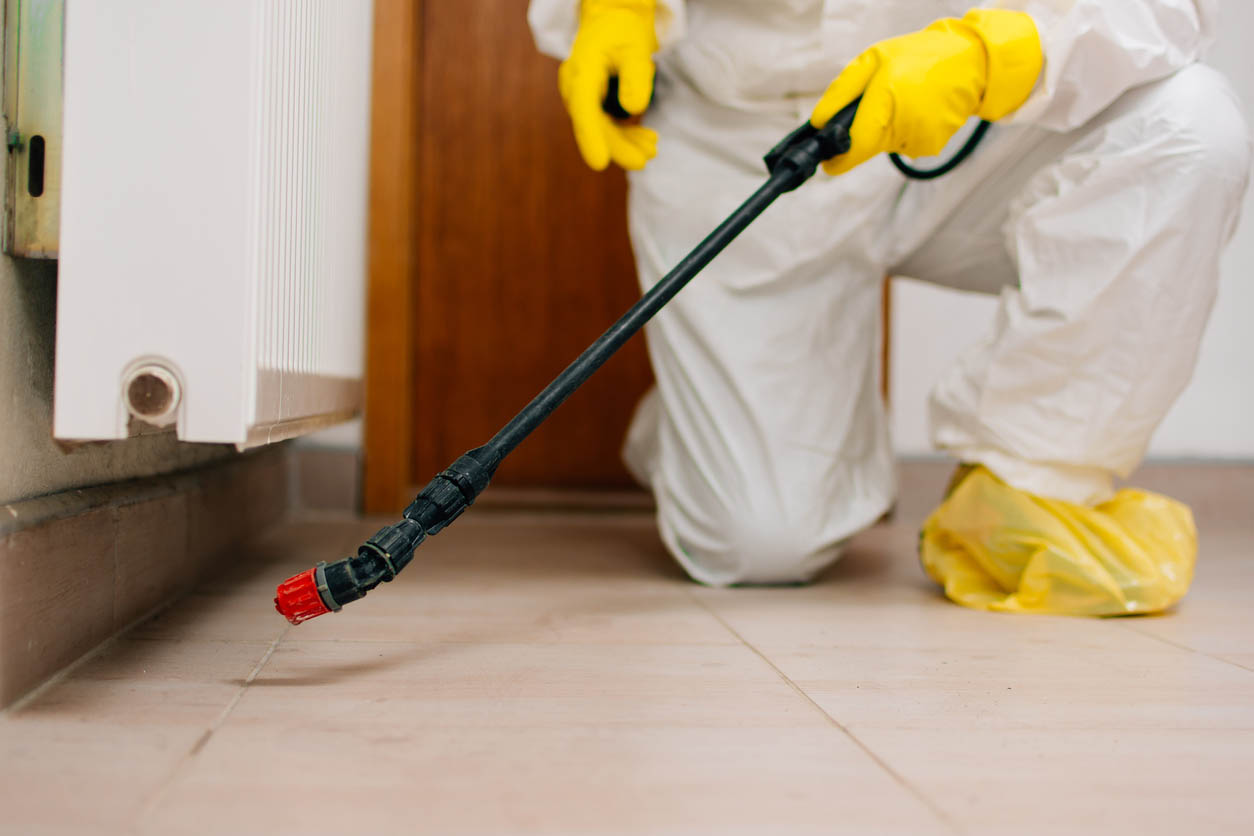
How to Save Money on Exterminator Cost
Pest control treatments are difficult to negotiate because the services are necessary and time-sensitive, so there isn’t much time to comparison shop and evaluate. In addition, it’s important to get the appropriate treatment for the infestation. Treating pests is not like building a house, where it’s possible to choose a lower grade of lumber or a simpler flooring tile—only the appropriate treatment will do. That doesn’t mean there aren’t ways to save some money by shopping wisely. The following may help lower exterminator costs.
- Get a referral. Talk to friends and neighbors for recommendations for exterminators; find out ahead of time who was cost-effective and got the job done. Also, some exterminators offer referral bonuses, so both you and a friend can save money if you use the friend’s name as a reference.
- Shop around. Seek several estimates, asking questions about payment plans and savings options.
- Look for discounts. Check local papers and websites for coupons.
- Act quickly. Pest problems grow exponentially and can go from small to overwhelming in a surprisingly short time.
- Explore payment options. Ask about paying for the whole course of treatment up front; often, exterminators will give you a discount for paying all at once. Other times financing may be offered if this isn’t feasible.
- Practice good prevention. Seal cracks, store garbage in a lidded can, and keep the yard trimmed and neat.
Questions to Ask an Exterminator
There are some standard questions homeowners or renters will want to ask any contractor. It’s advisable for customers to avoid hiring someone who isn’t licensed, insured, and bonded, or anyone who can’t provide references to contact (and it’s a good idea for customers to actually contact those references once provided). With exterminators, however, there are some additional questions for potential customers to ask about their procedures and costs.
- What pests have you found in my home?
- Where are the pests located?
- What treatments do you recommend, and why?
- Is there a less costly treatment that we could start with? Why or why not?
- How long/how many treatments will it take to eliminate the infestation?
- Will I need follow-up treatments? How much will that cost?
- How will the cost be affected if I need more treatments than you expect? Is that written into the contract?
- Will you itemize your contract and stand by the itemization?
- What kind of payment plans do you offer, and is there a benefit to paying up front?
- Will these treatments be safe for my family and pets? What precautions should I take?
- What else can I do to follow up and reduce the likelihood of reinfestation?
FAQs
Discovering pests in the home can feel like the last straw for homeowners and renters, especially since they have to live in the house while waiting for the problem to be corrected. For some people, this can lead to stress and sleeplessness, making the whole process more challenging to manage. Understanding the options can help.
Q. Do exterminators give free estimates?
Some extermination companies will offer free inspections and estimates, with some exclusions. Bed bug inspections are often an exception because hunting for bed bugs is an intensive process that requires a fair amount of time and furniture moving. In addition, inspections for real estate transactions also usually incur a fee, mainly because such inspections require the exterminator to fill out a form describing the inspection results. Companies that do not provide free inspections will often waive the inspection fee if the customer chooses to contract them for treatment services. Whether or not the inspection is free isn’t a reflection of the company’s quality, so base the choice on recommendations and not the initial consultation cost.
Q. Which pests require more than one treatment to control?
Fleas, ticks, and bed bugs will most likely need more than one treatment. The initial treatment will usually kill the adult insects, but larvae and eggs are notoriously difficult to kill, and there are most likely eggs and larvae in all different stages in the home, so it may take several waves of treatment to kill newly hatched insects before they can lay more eggs.
Q. What is the worst type of pest?
Termites are the worst type of interior pest. They eat through the wood in a house at an alarming rate and reproduce quickly, so they’re tough to find and tough to kill. They do billions of dollars’ worth of damage to homes every year. They’re closely followed by carpenter ants, which cause much the same type of damage but are more easily eradicated. Bed bugs, which don’t carry disease or harm people beyond potentially itchy bites, are tough to kill, so while they’re not dangerous, their removal can be a long and expensive prospect, and the sleeplessness they create makes the whole experience more stressful. Fire ants won’t do damage to a home, but they can build large nests quickly in walls and under floors inside and emerge to deliver painful bites that can cause severe allergic reactions. After becoming aware of these pests, call an exterminator promptly.
Sources: HomeAdvisor, Thumbtack, HomeGuide, Fixr
